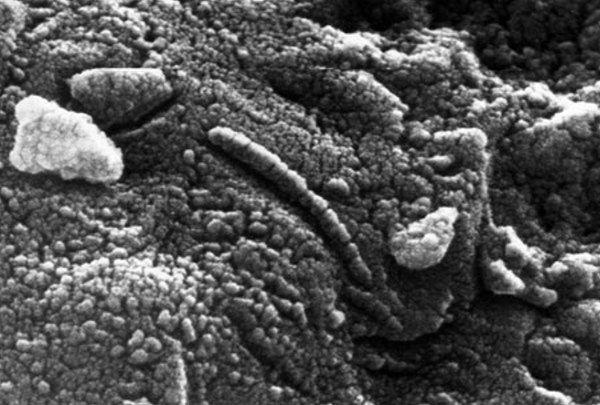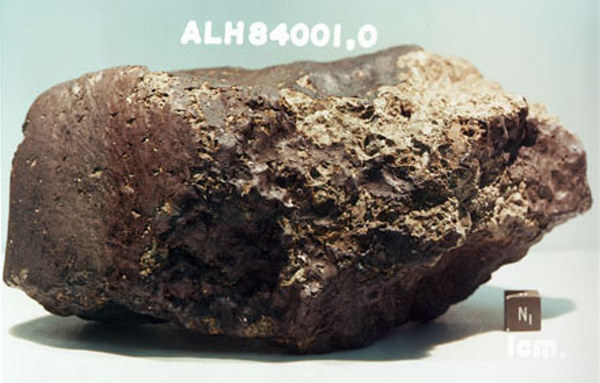History
This rock is theorized to be one of the oldest pieces of the solar system, proposed to have crystallized from molten rock 4.091 billion years ago.[2] Based on hypotheses surrounding attempts to identify where extraterrestrial rocks come from, it is supposed to have originated on Mars and is related to other Martian meteorites.
In September 2005, Vicky Hamilton of the University of Hawaii at Manoa presented an analysis of the origin of ALH 84001 using data from the Mars Global Surveyor and Mars Odyssey spacecraft orbiting Mars. According to the analysis, Eos Chasma in the Valles Marineris canyon appears to be the source of the meteorite.[3] The analysis was not conclusive, in part because it was limited to parts of Mars not obscured by dust.
The theory holds that ALH 84001 was shocked and broken by one or more meteorite impacts on the surface of Mars some 3.9 to 4.0 billion years ago, but remained on the planet. It was later blasted off from the surface in a separate impact about 15 million years ago and impacted Earth roughly 13,000 years ago. These dates were established by a variety of radiometric dating techniques, including samarium-neodymium (Sm-Nd), rubidium-strontium (Rb-Sr), potassium-argon (K-Ar), and carbon-14.[4][5]
It is hypothesized that ALH 84001 originated from a time period during which liquid water may have existed on Mars. Other meteorites that have potential biological markings have generated less interest because they do not originate from a "wet" Mars. ALH 84001 is the only meteorite collected from such a time period.[6]
Possible biogenic features
On August 6, 1996[6] ALH 84001 became newsworthy when it was announced that the meteorite may contain evidence for traces of life from Mars, as published in an article in Science by David McKay of NASA.[7]
 |
The announcement of possible extraterrestrial life caused considerable controversy at the time and opened up interest in Martian exploration. When the discovery was announced, many immediately conjectured that the fossils were the first true evidence of extraterrestrial life—making headlines around the world, and even prompting U.S. President Bill Clinton to make a formal televised announcement to mark the event.[9]
Several tests for organic material have been performed on the meteorite and amino acids and polycyclic aromatic hydrocarbons (PAH) have been found. The debate over whether the organic molecules in the meteorite are in fact of exobiologic origin or are due to abiotic processes on Mars or contamination from the contact with Antarctic ice on Earth is still ongoing.[10][11]
Early on, Ralph Harvey of Case Western Reserve University and Harry McSween of University of Tennessee reported evidence that the carbonate globules found in the meteorite were formed at high temperature (above 650°C) by volcanic or impact processes on Mars.[12] At such high temperatures, it would be very unlikely that the morphology of the globules could have had any kind of biological origin. Later, however, the same authors published papers supporting a hypothesis in which the globules formed at low temperature from an aqueous solution. Most scientific papers published in the past 10 years now accept that carbonates on Mars formed this way.[13]
Other initial skepticism towards the biogenic hypothesis focused on the idea that the nanometer-sized filaments were too small to contain RNA, but evidence continues to grow that nanobacteria do exist in nature.[14] Furthermore, microbiologists have successfully cultured nanobacteria in the lab, with sizes within the range of at least some of the purported microfossils in ALH 84001.[15]
Some experts argue that the biomorphs found in the meteorite are not indicative of life on Mars, but instead are caused by contamination by earthly biofilms. However, scientists at NASA argue that likely microbial terrestrial contamination found in other Martian meteorites do not resemble the texture of the biomorphs in ALH 84001. In particular, the biomorphs in ALH 84001 look intergrown or embedded in the indigenous material, while likely contamination do not.[13]
While it has not yet conclusively been shown how the features in the meteorite were formed, similar features have been recreated in the lab without biological inputs by a team led by D.C. Golden of Hernandez Engineering Inc. in Houston.[16] David McKay says these results were obtained using unrealistically pure raw materials as a starting point,[6] and "will not explain many of the features described by us in ALH84001." According to McKay, a plausible inorganic model "must explain simultaneously all of the properties that we and others have suggested as possible biogenic properties of this meteorite."[16]
In November 2009, a team of scientists at Johnson Space Center, including David McKay, reasserted that there is "strong evidence that life may have existed on ancient Mars", after having reexamined the meteorite using more advanced analytical instruments now available, in light of the objections that had been made since the biogenic hypothesis for the biomorphs first had been put forward.[17][18] Overall, the team concluded that:
None of the original features supporting our hypothesis for ALH84001 has either been discredited or has been positively ascribed to non-biologic explanations.[13]In addition, they argued that since the original paper was published, the biogenic hypothesis has been "further strengthened by the presence of abundant biomorphs in other Martian meteorites."[13]
Student participation
The initial analysis of ALH 84001 was unusual in that an undergraduate student, Anne Taunton of the University of Arkansas, performed much of the SEM work used to correlate the suspected nanobacterial fossils with known terrestrial nanobacterial fossils. NASA's David McKay hired Anne Taunton for a 10-week student internship to perform the SEM analysis, but did not inform her about the nature of what she was investigating.[19] This technique is known as a single blind. Taunton reported the morphology of the biomorphs in ALH 84001 to be very similar to terrestrial samples without knowing that she was describing a Martian meteorite.
References:
- Meteoritical Bulletin Database: Allan Hills 84001
- Lapen, T. J.; et al. (2010). "A Younger Age for ALH84001 and Its Geochemical Link to Shergottite Sources in Mars". Science328 (5976): 347-351. doi:10.1126/science.1185395. PMID20395507
- Birthplace of famous Mars meteorite pinpointed. New Scientist article. URL accessed March 18, 2006.
- Nyquist, L. E.; Wiesmann, H.; Shih, C.-Y.; Dasch, J. (1999). "Lunar Meteorites and the Lunar Crustal SR and Nd Isotopic Compositions". Lunar and Planetary Science 27: 971. Bibcode: 1996LPI....27..971N
- Borg, Lars; et al. (1999). "The Age of the Carbonates in Martian Meteorite ALH84001". Science 286 (5437): 90-94. doi:10.1126/science.286.5437.90. PMID10506566
- Crenson, Matt (2006-08-06). "After 10 years, few believe life on Mars". Associated Press (on usatoday.com)
- McKay, David S.; et al. (1996). "Search for Past Life on Mars: Possible Relic Biogenic Activity in Martian Meteorite ALH84001". Science273 (5277): 924-930. doi:10.1126/science.273.5277.924. PMID8688069
- McSween, H. Y. (1997). "Evidence for life in a martian meteorite?". GSA Today7 (7): 1–7. PMID11541665.
- Clinton, Bill (1996-08-07). "President Clinton Statement Regarding Mars Meteorite Discovery". NASA
- Bada, J. L.; Glavin, D. P.; McDonald, G. D.; Becker, L. (1998). "A Search for Endogenous Amino Acids in Martian Meteorite ALH84001". Science 279 (5349): 362-365. doi:10.1126/science.279.5349.362. PMID9430583
- Becker L., Glavin D. P., Bada J. L. (1997). "Polycyclic aromatic hydrocarbons (PAHs) in Antarctic Martian meteorites, carbonaceous chondrites, and polar ice". Geochimica et Cosmochimica Acta 61 (2): 475-481. doi:10.1016/S0016-7037(96)00400-0. PMID11541466
- Harvey, R. P., and J. H. Y. McSween, "A possible high-temperature origin for the carbonates in the Martian meteorite ALH84001", Nature, 382(6586), 49-51, (1996).
- http://www.nasa.gov/centers/johnson/pdf/403089main_7441-1.pdf
- Cisar J, Xu D, Thompson J, Swaim W, Hu L, Kopecko D (2000). "An alternative interpretation of nanobacteria-induced biomineralization". PNAS97 (21): 11511–11515. doi:10.1073/pnas.97.21.11511. PMID11027350
- http://www.agu.org/sci_soc/eisromanek.html
- http://www.nasa.gov/centers/johnson/news/releases/2004/J04-025.html
- New Study Adds to Finding of Ancient Life Signs in Mars Meteorite - NASA. 2009-11-30
- Thomas-Keprta, K., S. Clemett, D. McKay, E. Gibson and S. Wentworth 2009. Origin of Magnetite Nanocrystals in Martian Meteorite ALH84001 journal Geochimica et Cosmochimica Acta: 73. 6631-6677
- Taylor, Michael Ray, 1999. Dark Life. 0684841916, p. 90
- Mittlefehldt D. W. (1994) "ALH84001, a cumulate orthopyroxenite member of the SNC meteorite group". Meteoritics, 29, 214-221. URL accessed March 18, 2006.
- Stephan T., Jessberger E. K., Heiss C. H. and Rost D. (2003) "TOF-SIMS analysis of polycyclic aromatic hydrocarbons in Allan Hills 84001". Meteorit. Planet. Sci. 38, 109–116.
- Allan Treiman's dissection of ALH84001 literature for the non-specialist
- Birthplace of famous Mars meteorite pinpointed. - New Scientist article
- Deception Point - fiction around an ALH84001 theme
- Evidence of Ancient Martian Life in Meteorite ALH84001? - NASA
- Life on Mars
- Magnetic Chains from Mars - Curious chains of magnetic crystals have turned up in a meteorite from Mars. Why didn't the single-file crystals collapse long ago into a magnetized clump? Scientists say ancient martian microbes may have kept them in line. - NASA - February 28, 2001
- Martian Micro-Magnets - The Allan Hills meteorite from Mars is peppered with tiny magnetic crystals that on our planet are made only by bacteria. - NASA
- Meteoritical Bulletin Database: Allan Hills 84001
- Nakhla meteorite
- NASA - The ALH 84001 Meteorite
- New Evidence Strengthens Claims of Ancient Life on Mars Study of Martian Meteorite Reveals Magnetic Fossils - NASA - February 26, 2001
- New Martian meteorites found - NASA - Astrobiology - Latest News - Nov 13, 2007
- New Report Offers Evidence of Primitive Life on Mars - NASA - December 13, 2000
- New Study Adds to Finding of Ancient Life Signs in Mars Meteorite - NASA - 2009-11-30
- No Life In Mars Meteorite, UH Scientists Reaffirm - NASA - August 14, 1998
- Panspermia, or more correctly Exogenesis
- Shergotty meteorite
- Study May Cast Doubt on some 1996 Evidence of past life on Mars - NASA - May 5, 2004
Release: Evidence of Primitive Life From Mars - NASA - August 7, 1996
- Life on Mars : Evidence from Martian Meteorites - [PDF][Archived]
- Meteorites from Mars ! - [PDF][Archived]
- New Evidence Strengthens Claims of Previous Life on Mars - [PDF][Archived]

